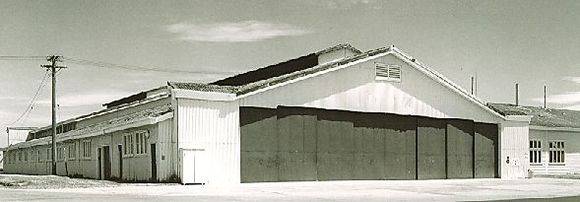| Back to search results » | Back to search page » |
|
Hangar No 95 - R.A.A.F. Base - Point Cook
LocationPoint Cook Road, POINT COOK VIC 3030 - Property No B2978
File NumberB2978LevelState |
|
Statement of Significance
Statement of Significance for Southern Tarmac Area: The RAAF Base Point Cook southern tarmac group of buildings, facilities and adjacent airfield make up a living complex of great significance in early aviation in Australia. Building commenced in 1914, a time when aircraft were a novelty, with the erection of the workshop for aeroplanes and aeroplane hangar, followed by a flight office (1915) now removed to the northern tarmac, seaplane jetty (1916), battle plane hangar and equipment store (1917), the latter building now removed to the northern tarmac, aeronautics school and motor garage (1922), seaplane hangar (1927), magazine and pyrotechnics store and electric sub-station (1934), gunnery stop butt (1935), new astronautics school (1936), seaplane squadron headquarters (1938), and new navigation school, new wireless school and inflammable store (1930). From 1914 to 1929 the works were undertaken under the direction of the architect, subsequently chief architect for the Commonwealth, John Smith Murdoch. The first transcontinental flight to Darwin (1920), the first round Australia flight (1924) and the first non-stop flight to Perth (1928) were all made from Point Cook. Although the uses of the structures have changed, the complex remains an operating element in an airforce base still directly engaged in flying training and student aviators still use the adjacent airfield which was commissioned in 1914 for that purpose. Classification on the Southern Tarmac Area comprising:- Building No 90 Former Motor Garage (1922), 91 Former Aeronautics School (1922), 92 New Aeronautics School (1936), 93 Former New Air Navigation School (1939), 96 Former New Wireless School (1939), 100 Former Seaplane Squadron Headquarters (1938), 101 Former Seaplane Hangars (1927 & 40), 108 Former Seaplane Jetty (1918, 1927/28, 1937/38), 232 & 233 Bases of Former Buildings 105 &106 (c.1918), 121 Former Gunnery Stop Butt (1935), 72W Former Flight Office Casualty Room (1915) now Barracks Office, 72E Equipment & Bedding Store, still Bedding Store (1917), 97 & 119 Magazine & Pyrotechnics Store (1934), 122 Inflammable Store (1939), 120 Electric Sub-station (1934). The Statement of Significance for the Classified Group, the Parade Ground and Domestic Group Group: A precinct of initially Australian Flying Corps, now Royal Australian Air Force, residential and administrative buildings erected between 1914 and 1939, initially under the direction of J. B. Murdoch, subsequently Chief Architect of the Commonwealth. The Headquarters Building (No 87) was erected in 1929 as the focal point of Point Cook's Parade Ground precinct. It is located at the centre of the main north-south axis of the base. The building, with its attendant structures and landscaping, is critical to the character of RAAF Point Cook. It is carefully composed on an axial theme to the domestic scale and character typical of Point Cook from 1914 until the Second World War. The group includes the general parade ground (1930), flag pole and base originally erected about 1920 and resited to its present position about 1930, and the memorial to Australian airmen of World War 1 (1938). The modern saluting base (Building No 99) is excluded from the Recording. The domestic precinct is unique as the residential zone for many of Australia's World War 1 aviators undergoing flying training who went on to become founders of the RAAF and of Australia's aviation industry. With the exception of the caretaker's cottage this area still contains all the surviving residential buildings erected at Point Cook prior to the formation of the RAAF in 1921. These domestic flavoured buildings, in what has been termed the "Early Commonwealth Vernacular" style, are uniformly set back from Cole Street with a wide grassed communal frontage. They form a visually coherent streetscape, which although not intact in its 1914-16 configuration, was designed in its present form in 1917-18. The Cole Street vista is enhanced by the parallel rows of trees on the south side. The National Trust has Classified in its own right Building No 18, the former Officers' Mess, now Sergents' Mess, with the following citation:- Erected in 1918 as part of extensive additions to facilities for officers, the Single Officers' Mess and Recreation building represented, with Building No 23, the first stage of the Officers' precinct. The building was the first separate mess building erected for air force officers in Australia. Its low-key informality is indicative of the lack of pretension in the young organisation. The enclosure of the verandah and other minor alterations are excluded from the Classification as are unsympathetic internal additions. The Classified Group, the Parade Ground and Domestic Group, consist of :- Parade Ground, Headquarters Building, Flagpole, Memorial, Married Quarters No 56004 (1914-15), No 56005 (1914-1915), No 56008 (1914-15), No 56007 (1928), No 56008 (1928), No 56009 (1928), No 56010 (1914-15), No 56011 (1915-16), No 18 Former Officers' Mess now Sergents' Mess (1918), No 488 Former Single Officers' Quarters (1914-18), No 23 Former Single Officers' Quarters now senior N.C.O.'s Quarters (1918), No 24 Cadets' Quarters (1935), No 28 Now Officers' Quarters (1935), No 29 (1928), No 27 (1939), No 30 Water Tanks (now disused) (1918-1923), No 56026 Former Caretaker's Quarters (1914-1915) (now in Dalzell Road).
Classified: 16/03/1978
Group
Military
Category
Defence Base Airforce




